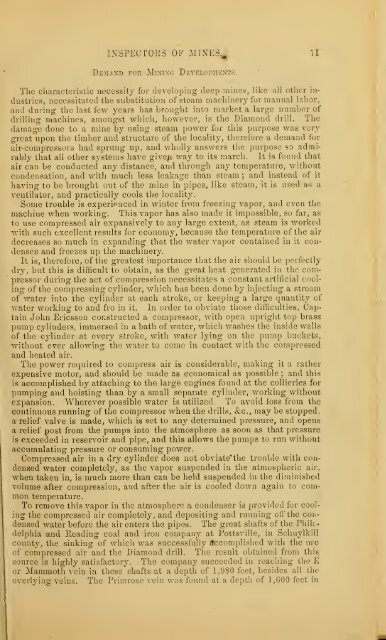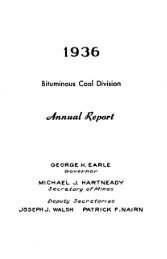Reports of the Inspectors of Mines of the anthracite coal regions of ...
Reports of the Inspectors of Mines of the anthracite coal regions of ...
Reports of the Inspectors of Mines of the anthracite coal regions of ...
Create successful ePaper yourself
Turn your PDF publications into a flip-book with our unique Google optimized e-Paper software.
INSPECTORS OF MINES.^ U<br />
Dejuxd for Mi.vixg DeVELOI'MKNTS.<br />
The characteristic necessity for developing deep mines, like all o<strong>the</strong>r industries,<br />
necessitated <strong>the</strong> substitution <strong>of</strong> steam machinery for manual labor,<br />
and during <strong>the</strong> last few years has brought into market a large number <strong>of</strong><br />
drilling machines, amongst which, however, is <strong>the</strong> Diamond drill. The<br />
damage done to a mine by using steam power for this purpose was very<br />
great upon <strong>the</strong> timber and structure <strong>of</strong> <strong>the</strong> locality, <strong>the</strong>refore a demand for<br />
air-compressors had sprung up, and wholly answers <strong>the</strong> purpose so admirably<br />
that all o<strong>the</strong>r systems have givep way to its march. It is found that<br />
air can be conducted any distance, and through any temperature, Avithout<br />
condensation, and with much less leakage than steam ; and instead <strong>of</strong> it<br />
having to be brought out <strong>of</strong> <strong>the</strong> mine in pipes, like steam, it is used as a<br />
ventilator, and practically cools <strong>the</strong> locality.<br />
Some trouble is experienced in winter from freezing vapor, and even <strong>the</strong><br />
machine when working. This vapor has also made it impossible, so far, as<br />
to use compressed air expansively to any large extent, as steam is worked<br />
with such excellent results for economy, because <strong>the</strong> temperature <strong>of</strong> <strong>the</strong> air<br />
decreases so much in expanding that <strong>the</strong> water vapor contained in it condenses<br />
and freezes up <strong>the</strong> machinery.<br />
It is, <strong>the</strong>refore, <strong>of</strong> <strong>the</strong> greatest importance that <strong>the</strong> air should be perfectly<br />
dry, but this is difficult to obtain, as <strong>the</strong> great heat generated in <strong>the</strong> compressor<br />
during <strong>the</strong> act <strong>of</strong> compression necessitates a constant artificial cooling<br />
<strong>of</strong> <strong>the</strong> compressing cylinder, which has been done by injecting a stream<br />
<strong>of</strong> water into <strong>the</strong> cylinder at each stroke, or keeping a large quantity <strong>of</strong><br />
Avater working to and fro in it. In order to obviate those difficulties. Captain<br />
John Ericsson constructed a compressor, with open upright top brass<br />
pump cylinders, immersed in a bath <strong>of</strong> water, which washes <strong>the</strong> inside walls<br />
<strong>of</strong> <strong>the</strong> cylinder at every stroke, with water lying on <strong>the</strong> pump buckets,<br />
without ever allowing <strong>the</strong> water to come in contact with <strong>the</strong> compressed<br />
and heated air.<br />
The power required to compress air is considerable, making it a ra<strong>the</strong>r<br />
expensive motor, and should be made as economical as possible ; and this<br />
is accomplished by attaching to <strong>the</strong> large engines found at <strong>the</strong> collieries for<br />
pumping and hoisting than by a small separate cylinder, working without<br />
expansion. AVherever possible water is utilized. To avoid loss from <strong>the</strong><br />
continuous running <strong>of</strong> <strong>the</strong> compressor when <strong>the</strong> drills, &c., may be stopped,<br />
a relief valve is made, which is set to any determined pressure, and opens<br />
a relief post from <strong>the</strong> pumps into <strong>the</strong> atmosphere as soon as that pressure<br />
is exceeded in reservoir and pipe, and this allows <strong>the</strong> pumps to run without<br />
accumulating pressure or consuming power.<br />
Compressed air in a dry C3dinder does not obviate* <strong>the</strong> trouble with condensed<br />
water completely, as <strong>the</strong> vapor suspended in <strong>the</strong> atmospheric air,<br />
when taken in, is much more than can be held suspended in <strong>the</strong> diminished<br />
volume after compression, and after <strong>the</strong> air is cooled down again to common<br />
temperature.<br />
To remove this vapor in <strong>the</strong> atmosphere a condenser is provided for cooling<br />
<strong>the</strong> compressed air completely, and depositing and running <strong>of</strong>f <strong>the</strong> condensed<br />
water before <strong>the</strong> air enters <strong>the</strong> pipes. The great shafts <strong>of</strong> <strong>the</strong> Pliili.delphia<br />
and Reading <strong>coal</strong> and iron company at Pottsville, in Schuylkill<br />
county, <strong>the</strong> sinking <strong>of</strong> which was successfally Accomplished with <strong>the</strong> use<br />
<strong>of</strong> compressed air and <strong>the</strong> Diamond drill. The result obtained from this<br />
source is highly satisfactory. The company succeeded in reaching <strong>the</strong> E<br />
or Mammoth vein in <strong>the</strong>se shafts at a depth <strong>of</strong> 1,980 feet, besides all <strong>the</strong><br />
overlying veins. The Primrose vein was found at a depth <strong>of</strong> 1,G00 feet in




![1945 Anthracite Annual Report Districts 19 - 25 [Adobe pdf - 9148Kb]](https://img.yumpu.com/50308099/1/190x119/1945-anthracite-annual-report-districts-19-25-adobe-pdf-9148kb.jpg?quality=85)


![1937 Anthracite Annual Report Districts 1 - 11 [Adobe pdf - 9394Kb]](https://img.yumpu.com/43539962/1/190x119/1937-anthracite-annual-report-districts-1-11-adobe-pdf-9394kb.jpg?quality=85)







![1931 Anthracite Annual Report Districts 1 - 11 [Adobe pdf - 8007Kb]](https://img.yumpu.com/39427789/1/190x119/1931-anthracite-annual-report-districts-1-11-adobe-pdf-8007kb.jpg?quality=85)

